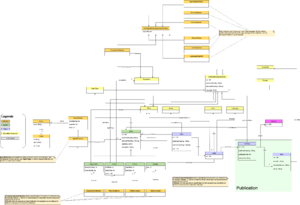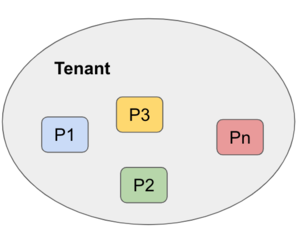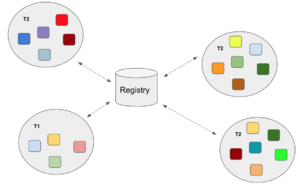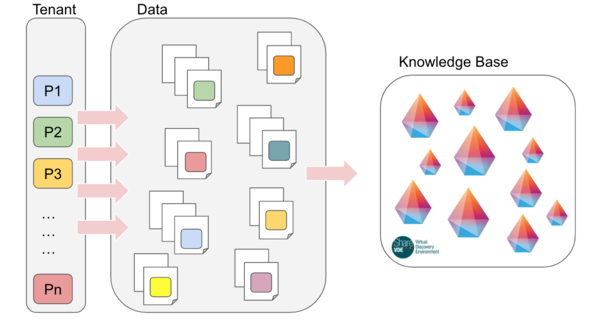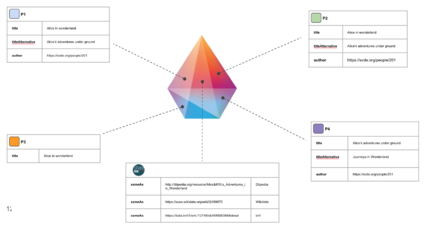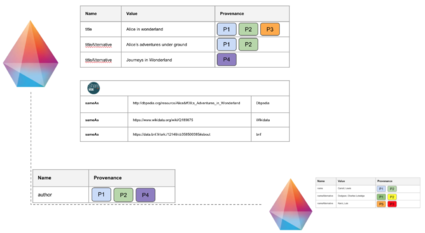(Created page with "==Introduction== '''Share-VDE''' manages a '''Knowledge Base''' which consists of '''clustered''', '''integrated''' and '''enriched entities'''. In Share-VDE, a '''tenant''' i...") |
No edit summary |
||
| (12 intermediate revisions by the same user not shown) | |||
| Line 1: | Line 1: | ||
==Introduction== | ==Introduction== | ||
Share-VDE manages a complex domain composed by several entities. That results in a complex graph of interconnected entities that can be queried and used by external requestors through a rich set of public APIs. The purpose of this section is to describe what a requestor can do in terms of API in order to interact with Share-VDE. | |||
At the heart of the system there's a '''complex domain model,''' as depicted in the following diagram: | |||
[[File:Share_VDE_Domain_Model.png|alt=Share VDE Domain Model|none|thumb]] | |||
The domain is composed by '''functional''' and '''technical''' entities, meaning with that a simple classification where we denote as | |||
* '''"functional"''' those entities that are part of the Share-VDE Core Domain Model (e.g. Agents, Opuses, Works, Instances, Items) | |||
*'''"technical"''' those entities required by some '''technical constraint''' in order to enrich the core entities with additional information (e.g. Collections, Facets, Pagination metadata). | |||
=== Knowledge Base, Tenants, Provenances === | |||
'''Share-VDE''' manages a '''Knowledge Base''' which consists of '''clustered''', '''integrated''' and '''enriched entities'''. In Share-VDE, a '''tenant''' is represented by a set of '''institutions''' contributing to the '''same Knowledge base'''. | '''Share-VDE''' manages a '''Knowledge Base''' which consists of '''clustered''', '''integrated''' and '''enriched entities'''. In Share-VDE, a '''tenant''' is represented by a set of '''institutions''' contributing to the '''same Knowledge base'''. | ||
[[File:svde-ckb-provenance-tenant.png|none|thumb]] | [[File:svde-ckb-provenance-tenant.png|none|thumb]] | ||
An institution '''Pn''' within a tenant is called '''provenance'''. We use that term because we always want to '''retain''' the '''relationship''' between '''Share-VDE entities''' and '''data''' that '''originally contributed''' to their building. | An institution '''Pn''' within a tenant is called '''provenance'''. We use that term because we always want to '''retain''' the '''relationship''' between '''Share-VDE entities''' and '''data''' that '''originally contributed''' to their building. | ||
===Multiple Tenants | ===Multiple Tenants? The Share-VDE Family=== | ||
Multiple tenants form the '''Share Family'''. Family members interoperate through a centralised registry. | Multiple tenants form the '''Share Family'''. Family members interoperate through a centralised registry. | ||
[[File:share-family.png|none|thumb]] | [[File:share-family.png|none|thumb]] | ||
===Share-VDE | ===Share-VDE Entities=== | ||
In the following diagram we depicted a high-level overview of the clusters genesis process. | In the following diagram we depicted a high-level overview of the clusters genesis process. | ||
[[File:data-to-svde-clusters.png|none|thumb|589x589px]] | [[File:data-to-svde-clusters.png|none|thumb|589x589px]] | ||
| Line 17: | Line 27: | ||
*The '''Share-VDE clusters''' are created in the '''Knowledge Base''' by means of an automatic process we simply call '''"clustering"''' | *The '''Share-VDE clusters''' are created in the '''Knowledge Base''' by means of an automatic process we simply call '''"clustering"''' | ||
===The Share-VDE | ===The Share-VDE Entity: The Prism=== | ||
Each Share-VDE cluster is the result of merging contributions from several sources, including a special enrichment for linking external sources (e.g. VIAF, ISNI). | Each Share-VDE cluster is the result of merging contributions from several sources, including a special enrichment for linking external sources (e.g. VIAF, ISNI). | ||
| Line 23: | Line 33: | ||
[[File:prism 1.png|none|thumb|424x424px]] | [[File:prism 1.png|none|thumb|424x424px]] | ||
[[File:prism 2.png|none|thumb|425x425px]] | [[File:prism 2.png|none|thumb|425x425px]] | ||
===API Perspective=== | ===API Perspective=== | ||
Each cluster type has a '''"provenances"''' field associated which, as the name suggests, indicates the '''provenances that contributed''' to that cluster definition. | Each cluster type has a '''"provenances"''' field associated which, as the name suggests, indicates the '''provenances that contributed''' to that cluster definition. | ||
| Line 99: | Line 70: | ||
} | } | ||
} | } | ||
</syntaxhighlight | </syntaxhighlight> | ||
Latest revision as of 08:49, 8 February 2024
Introduction
Share-VDE manages a complex domain composed by several entities. That results in a complex graph of interconnected entities that can be queried and used by external requestors through a rich set of public APIs. The purpose of this section is to describe what a requestor can do in terms of API in order to interact with Share-VDE.
At the heart of the system there's a complex domain model, as depicted in the following diagram:
The domain is composed by functional and technical entities, meaning with that a simple classification where we denote as
- "functional" those entities that are part of the Share-VDE Core Domain Model (e.g. Agents, Opuses, Works, Instances, Items)
- "technical" those entities required by some technical constraint in order to enrich the core entities with additional information (e.g. Collections, Facets, Pagination metadata).
Knowledge Base, Tenants, Provenances
Share-VDE manages a Knowledge Base which consists of clustered, integrated and enriched entities. In Share-VDE, a tenant is represented by a set of institutions contributing to the same Knowledge base.
An institution Pn within a tenant is called provenance. We use that term because we always want to retain the relationship between Share-VDE entities and data that originally contributed to their building.
Multiple tenants form the Share Family. Family members interoperate through a centralised registry.
In the following diagram we depicted a high-level overview of the clusters genesis process.
Starting from the left side we have:
- A tenant composed by n institutions (P1...Pn)
- Institutions contribute with their raw data (e.g. bibliographic records, authority records)
- The Share-VDE clusters are created in the Knowledge Base by means of an automatic process we simply call "clustering"
Each Share-VDE cluster is the result of merging contributions from several sources, including a special enrichment for linking external sources (e.g. VIAF, ISNI).
We like to imagine a cluster like a prism, which is a whole unit and at the same time it retains several faces (the contribution of each source). See the following diagrams for a visual explanation
API Perspective
Each cluster type has a "provenances" field associated which, as the name suggests, indicates the provenances that contributed to that cluster definition.
Here's an example of a request which asks for a specific Person and its provenances:
{
person(uri: "https://svde.org/agents/201") {
uri
name
provenances {
uri
description
}
}
}
In the response below we clearly see the Share-VDE cluster for Luiss Carroll has been contributed by 3 institutions: Stanford, Alberta and British Library.
{
"data": {
"person": {
"uri": "https://svde.org/agents/201",
"name": "Carroll, Luiss",
"provenances": [
{
"uri": "https://svde.org/agents/STANFORD",
"description": "Stanford University"
},
{
"uri": "https://svde.org/agents/BL",
"description": "British Library"
},
{
"uri": "https://svde.org/agents/UALBERTA",
"description": "University of Alberta"
}
]
}
}
}
